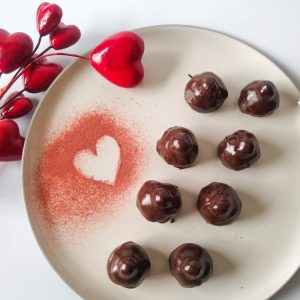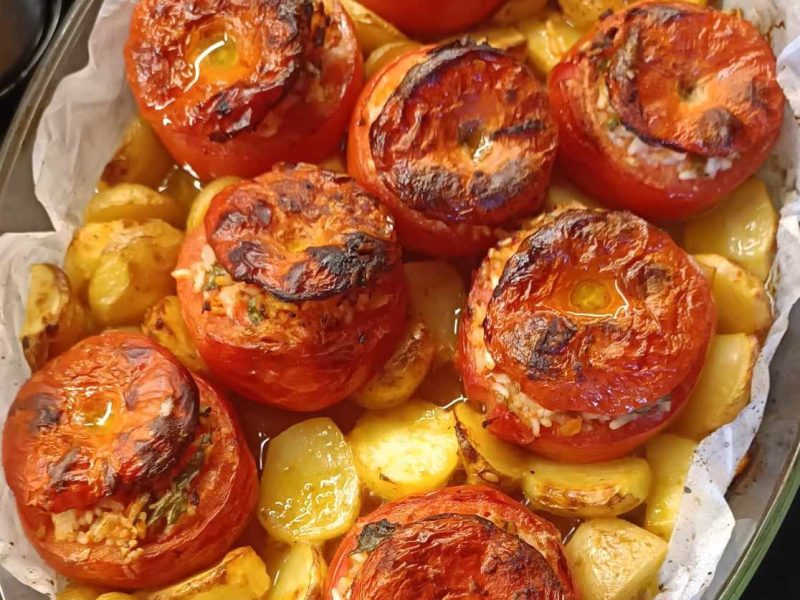
Valentine’s Day and chocolate go hand in hand pretty much anywhere in the world, but in Italy this bonbon has a very distinctive name (and shape): it’s the Baci (“kisses”) Perugina. An earthy chocolate hazelnut filling coated in the finest dark chocolate, wrapped in a little love message: the Italian, romantic, nut-brown version of a fortune cookie, basically!
We have eaten Baci Perugina by the handful, even if that meant buying them ourselves (you are supposed to receive them as a Valentine present from your sweetheart), we have a passion for everything that’s simple, wholesome, homemade and more importantly packed with HAZELNUTS: so who better then us could embark in this endeavour to recreate the famous Valentines truffles using minimal ingredients and equipment?

Most homemade version of the Baci Perugina will call for butter, double cream, hazelnut spread and – of course – sugar, which is quite similar to the original truffle. Our recipe is simplified to its bare essentials: hazelnuts and chocolate. This doesn’t mean you will end up with a copycat Bacio, but a much healthier one! In fact, if you decide to use the same good quality dark chocolate for both the filling and the coating, you will be able to indulge in a low carb, no added sugar truffle rich in antioxidants from both the hazelnuts and the cocoa. Not to mention all the vitamins, minerals and healthy fats! OK, we are not trying to suggest you can swap your 5 a day with one of our Valentine’s truffles, but at least you can indulge in them without too much guilt.
As every recipe in this world can be made yours. If you have a sweeter tooth you could opt for milk or white chocolate for the filling: we still recommend using dark chocolate for the coating for the best results. If you want to stick to dark chocolate for both the filling and the coating but you are worried the truffles will turn out a tad too bitter for your likings, you can add a little white or cane sugar. Swap vegan chocolate and you will have… guess what? A vegan truffle! You choose your adventure here.

The secret is all about using the roasted hazelnuts (invest in good quality and your palate will appreciate) to achieve three different textures:
- Nut butter to replace dairy butter or coconut oil. If you want to skip this step you can substitute it with our Homemade Nutella or any hazelnut spread of your choice;
- Chopped hazelnuts for crunchiness;
- A whole hazelnut on top because this truffle needs a hat!
Also, it might seem a bit of a nonsense to chop/grind the hazelnuts before and after mixing them with the melted chocolate, but we found that this step was necessary to achieve a texture that could be shaped in little balls so bear with us!
On this note, we used a 500ml, 500W food processor: this allowed us to work with small quantities. If you are into making your own nut butters you will probably already have one of these amongst your kitchen appliances, if not you might need to do a double batch! Trust us, it will go in no time.

A note on tempering the chocolate. To many of us this might sounds like an unnecessary step: you might have a point here. Tempering chocolate can be avoided, however, our fuss-free method below only took us 15 mins extra and we think that having a shinier, ‘snappier’ coating was worth the trouble. All you need for this is a microwave-proof bowl, a spatula and a candy thermometer.
Enough for the talking, let’s get melting baking!

Two Ingredient Valentine’s Hazelnut Truffles
Equipment
- Food processor
- Candy thermometre
Ingredients
- 60 g Chocolate of choice Dark, Milk, White
- 300 g Roasted Hazelnuts
- 150 g Dark chocolate for coating
Optional
- Sugar optional
Instructions
- Keep 18-20 hazelnuts aside. Then take about 60-80g of hazelnut or as (little as your food processor can handle) and grind them into a smooth butter. We will only be using a small quantity but most food processor need at least a handful of hazelnuts to be able to work properly. You can skip this step and use our Homemade Nutella or any hazelnut spread of your choice.
- Chop or coarsely grind the remaining hazelnuts (roughly 220g).
- Melt the 60g of chocolate in a small bowl in your microwave. Remember to work at 30 seconds intervals to make sure not to burn it!
- Mix the melted chocolate and the chopped hazelnuts, making sure you have still some on the side in case you need to adjust the consistency. Add about 20g of the hazelnut butter.
- Put the chopped hazelnuts and melted chocolate back into the food processor and give them a quick blitz.
- Shape the chocolate hazelnut mix into 18 truffles and then place a whole hazelnut on top, applying gentle pressure: the mix is still not set and will crumble quite easily. Refrigerate for a couple of hours.
- When the truffles have set in the fridge for 1.5 hours you can start tempering the chocolate for the coating. If you decide (recommended) to temper your chocolate, have a look at the relevant group of instructions below, otherwise melt your chocolate in the microwave at 30 seconds increments. Let it set for a few minutes.
- Coat your truffles. We placed them on a baking grill and poured the chocolate on top of each one of them with a spoon, but you can use a fork to dive them one by one in the melted chocolate: this is slightly less messy although the baking grill method will give a neater result in our opinion (we tested both).
- Refrigerate preferably overnight and enjoy!
Tempering the chocolate
- This is our fuss-free method. All you need is a microwave safe bowl and a candy thermometre.
- Chop all your chocolate and divide it into roughly 4 parts. Keep 1/4 aside: this is your seed chocolate. Melt the remaining 3/4 in the microwave at 30 seconds increments.
- Once your chocolate has reached the temperature of 50-55 degrees, you can put the seed chocolate in and start mixing. The purpose of this step is to take the temperature down to 29 degrees.
- When the chocolate reaches the desired temperature, you need to warm it back up to 31-32 degrees. We understand that it can be tricky to stick to the exact values, but try not to go too above or below the suggested temperature… we haven't been the most accurate either!


